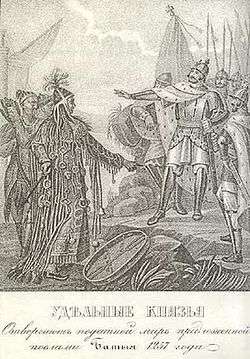Battle of Voronezh River
During the Mongol Invasion of Rus, the Principality of Ryazan was the first to be attacked.
| Mongol invasion of Rus' | |||||||
|---|---|---|---|---|---|---|---|
| Part of Mongol conquest of Eastern Europe | |||||||
 The Ryazan's prince rejects the Mongols’ tribute demand. | |||||||
| |||||||
| Belligerents | |||||||
| Mongol Empire | Principality of Ryazan | ||||||
| Commanders and leaders | |||||||
| Subutai |
Yuriy Igorevich of Ryazan Roman Ingvarevich of Kolomna | ||||||
| Strength | |||||||
| Several tumen of nomad cavalry[1] | A few hundred cavalry and no more than 1000–2000 militia on foot[1] | ||||||
| Casualties and losses | |||||||
| Light | Heavy, but some units escaped to Kolomna | ||||||
Opposing Forces
Main articles: Mongol military tactics and organization and Medieval Russian army
Size and composition of both armies can be roughly estimated based on contemporary chronicles.[2][3] Contemporary Mongol sources describe Batu as invading with 12-14 tumens, which would give him a nominal strength of 120.000-140.000 men, mostly nomad cavalry archers.[4] However, tumens were often at less than full strength, some elite units with as few as 1.000 horsemen.[2]
On the Russian side, contemporary sources mention only five princes by name,[3] each of whom would be accompanied by his Druzhina, a small retinue of heavy cavalry.[5] The princely retinue surpassed the Mongolian army in armament, both offensive and defensive. Massively heavy armor was used. However, these squads, as a rule, did not exceed the number of several hundred men, and were unsuitable for united actions under a single command.[6]
At the same time, the main part of the Old Russian army was the militia infantry. It was inferior to the nomads in armament and the ability to own it. The militia used axes and hunting spears ("rogatina"). Swords were rarely used, and they had no armor other than plain clothes and fur hats.[5]
For the infantry, consisting of poorly armed peasants and tradesmen, numbers are uncertain. The only specific numbers mentioned for the Russians are 1.700 men of Evpaty Kolovrat[7](The Tale of the Destruction of Ryazan) and 3.000 men under Voivode Dorozh[3](Battle of the Sit River). However, these were exceptionally large numbers for Russian standards at the time. In 1242, Prince Alexander Nevski in Novgorod could muster no more than 1.000 Druzhina and 2.000 militia for the Battle on the Ice.[8] So, it is safe to estimate that, on average, a Russian prince had hundreds of warriors in his retinue, rather than thousands.
Battle
After receiving envoys of Batu Khan and sending them to their overlord, Yuri II of Vladimir,[7] border princes of Ryazan, Murom, and Pronsk gathered their forces and made a stand on the river Voronezh, waiting for reinforcements from Vladimir.[3] They received none, and their small force was quickly scattered.
Aftermath
After the battle, Prince Yuri Igorevich retreated to Ryazan, while his nephew Prince Roman took some of his men north to Kolomna and joined the army of Vladimir-Suzdal.[3]
References
- Grigorjevič., Jan, Vasilij (1991). Batu-kan : istorijski roman. Lobačev, Đorđe., BIGZ). Beograd: Prosveta. ISBN 8607005944. OCLC 438360055.
- ад-Дин, Рашид (1952). Сборник летописей / Пер. с персидского О. И. Смирновой,редакция проф. А. А. Семенова. Издательство Академии Наук СССР. pp. Т. 1, кн. 2. – С. 71.
- "Новгородская летопись". krotov.info. Retrieved 2018-02-24.
- 1898-1965, Nasonov, A. N. (Arseniĭ Nikolaevich); 1898-1965., Насонов, А. Н. (Арсений Николаевич) (2006). "Russkai︠a︡ zemli︠a︡" i obrazovanie territorii drevnerusskogo gosudarstva : istoriko-geograficheskoe issledovanie ; Mongoly i Rusʹ : istorii︠a︡ tatarskoĭ politiki na Rusi (Izdanie vtoroe, stereotipnoe ed.). Sankt-Peterburg. ISBN 5020269352. OCLC 913580743.CS1 maint: numeric names: authors list (link)
- Borisovich), Shirokorad, A. B. (Aleksandr; Борисович), Широкорад, А. Б. (Александр (2004). Rusʹ i Orda. Moskva: Veche. ISBN 5953302746. OCLC 56858783.
- Grigorʹevič., Hrustalev, Denis (2017). Rusʹ i mongolʹskoe našestvie : 20--50-e gg. XIII v. Sankt-Peterburg: Evraziâ. ISBN 9785918521427. OCLC 1003145949.
- "Никифоровская летопись. Никифорівський літопис. Том 35. Литовсько-білоруські літописи". litopys.org.ua. Retrieved 2018-02-25.
- 1944-, Nicolle, David (1996). Lake Peipus 1242 : battle of the ice. London: Osprey Military. ISBN 9781855325531. OCLC 38550301.CS1 maint: numeric names: authors list (link)